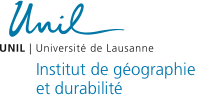Institute of Geography and Sustainability of the University of Lausanne
Research projects
Analysis, modelling and visualisation of spatiotemporal data for urban development
| Research fields |
Urban matters |
| Keywords |
Urban studies Visualisation Clustering |
| Funding | |
| Duration | September 2004 - September 2009 |
| Website | |
| Researchers |
Kaiser Christian (Doctoral student) [web] [email] |
The proportion of population living in or around cites is more important than ever. Urban sprawl and car dependence have taken over the pedestrian-friendly compact city. Environmental problems like air pollution, land waste or noise, and health problems are the result of this still continuing process. The urban planners have to find solutions to these complex problems, and at the same time insure the economic performance of the city and its surroundings. At the same time, an increasing quantity of socio-economic and environmental data is acquired. In order to get a better understanding of the processes and phenomena taking place in the complex urban environment, these data should be analysed. Numerous methods for modelling and simulating such a system exist and are still under development and can be exploited by the urban geographers for improving our understanding of the urban metabolism. Modern and innovative visualisation techniques help in communicating the results of such models and simulations. This thesis covers several methods for analysis, modelling, simulation and visualisation of problems related to urban geography. The analysis of high dimensional socio-economic data using artificial neural network techniques, especially self-organising maps, is showed using two examples at different scales. The problem of spatiotemporal modelling and data representation is treated and some possible solutions are shown. The simulation of urban dynamics and more specifically the traffic due to commuting to work is illustrated using multi-agent micro-simulation techniques. A section on visualisation methods presents cartograms for transforming the geographic space into a feature space, and the distance circle map, a centre-based map representation particularly useful for urban agglomerations. Some issues on the importance of scale in urban analysis and clustering of urban phenomena are exposed. A new approach on how to define urban areas at different scales is developed, and the link with percolation theory established. Fractal statistics, especially the lacunarity measure, and scale laws are used for characterising urban clusters. In a last section, the population evolution is modelled using a model close to the well-established gravity model. The work covers quite a wide range of methods useful in urban geography. Methods should still be developed further and at the same time find their way into the daily work and decision process of urban planners.
Publications
| Kaiser, C. (2010). Analysis, modelling and visualisation of spatiotemporal data for urban studies. PhD thesis, Université de Lausanne, Faculté des géosciences et de l'environnement. | Info |

